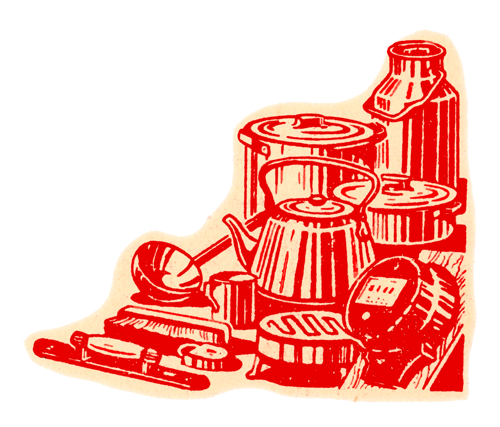



Annotation of the Exhibition
Examples of the Printed Advertisements in the Soviet Lithuania
Each American sees about 16 thousand advertisements every day, even though they don’t even consider it or deliberately choose to see them. Back in the previous century, the geographical public space in countries of market economy was replaced by graphics. What about the Soviet Lithuania, separated by the iron curtain?
In Lithuania, invaded by the USSR, the only commissioner and monopolist of advertising was the state, led by the sole communist party, following the ideological teachings of Marx and Lenin. The features of centralised economy and its legal framework practically ruined the market economy, developed during the period of the First Republic (1918–1940), at the same time changing the role of advertising as well.

According to the Oxford dictionary, in the 15th–16th centuries verb ‘advertise’ referred to an announcement; meanwhile, the word, used in Romance languages, originating from Latin ‘reclamare’, means to ‘shout and call’, which refers to the period of verbal dissemination of information. Advertising refers to the information, distributed in any form and by any means, with the aim to promote or produce an impact on certain social groups – citizens or certain users, consumers, etc. – in a way to make them comply with the objectives of the commissioner of the said information.
At the time popular science magazine “Science and Technology” (1965, No. 6, p. 37) claimed that ‘soviet advertising is more than labels, posters and press ads. Contrary to the capitalist advertising, which uses both fair and deceptive ways to persuade consumers to buy goods that can be equally good or bad, the purpose of soviet advertising is to inform the consumer about the advantages of the goods advertised. Socialist advertising coordinates the consumption of goods, based on the needs of the labour people and the interests of the people’s economy. Promoting the demand for a new type of products, it has a healthy positive impact on the industry. Moreover, helping to solve economic issues, soviet advertising shapes the consumers’ perception, contributes to developing their taste and improving their culture.’
What were the major roles of soviet advertising?
Information served to inform the residents (consumers) of the novelties (innovations), ideas, goods or services. Soviet advertising was characterised by the information, which was often limited. Sales and service ads were usually formal and boring, short, small, and often hardly noticeable. All adverts were usually placed on the back page of a publication rather than front page and their visuals were rather simple.

Propaganda served to educate, indoctrinate the consumers and shape their tastes. The main goal of the soviet authorities was to shape the soviet people, developing their soviet identity and obedience, and mobilising them for the set by purposes of the communist party. What made soviet advertising different was that the authorities believed that advertising was useful for achieving their purposes, putting all efforts to educate soviet citizens and make the advertising appealing. Short-term propaganda campaigns were usually organised by newspapers, radio and, later, television.
Disinformation (imitation) – served to imitate (witness) the supposed welfare of the soviet society, which was claimed to be more advanced than the capitalist Western countries, demonstrating a distorted and utopian picture of the communist society. Life in Lithuania during the soviet era was the same as in the rest of the USSR: nearly empty shops, lack of meat, butter, fruit, vegetables and very often even bread or other groceries. Residents had to wait in long queues just to buy furniture, dishes, more thought-provoking books, better quality clothes, cosmetics, music records, television sets, etc. There was also a lack of apartments: residents had to wait in certain queues, administered by the soviet authorities. There was a lack of medicine too – everything was in deficit. Thus advertising contributed to the illusion of a good life in the communist society.
It should be noted that, in reality, there were cases of soviet advertising, which also featured several social roles, which could also merge or double with others.
On the other hand, the developers of soviet advertising often copied certain adverts from the West. Intensive modernisation, urbanisation, increase in education level of the society and access to the information on flourishing Western economy, permeating the barriers of the USSR, increased the demands for life quality and consumer goods, also changed cultural norms and values. Although the assortment and quality of consumer goods did increase, they were always in deficit as the soviet economy could not satisfy all domestic and social needs of the residents. Taking care of the economic (business) matters, the soviet authorities tried to learn the art of advertising from the experience of communist (socialist) Eastern European countries as well as from the activities of Western advertising agencies. With the emergence of export advertising, it was necessary to understand the peculiarities of the Western advertising. The USSR engaged in active foreign trade, because it needed foreign currency. Factories and institutions started releasing individual advertising publications on their production in Russian and foreign languages, based on Western advertising examples.

In certain cases, the soviets sometimes copied things, forging information (data) on the quality of the goods or services. Soviet adverts deliberately (and for selfish purposes) provided incorrect information about the quality of goods without changing their appearance. For example, forged Western medicine (‘Aspirin’), forged alcohol, such as ‘champagne’, ‘cognac’, etc.
Referring to the soviet era, we often say that it was grey and dull. However, the deformed reality of the regime had its own internal tensions and paradoxes. The existence of advertising with no market economy or any free enterprise was one of them.
Was it colourful, loud and aggressive? Or, perhaps, minimalistic, precise and subtle? The virtual exhibition introduces to the examples of advertisements from soviet periodicals or individual publications, collected by the museum “Project – HOMO SOVIETICUS”.
